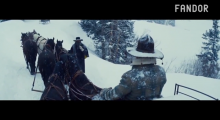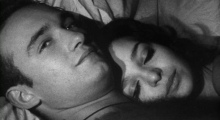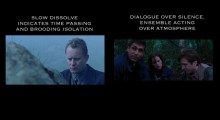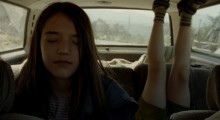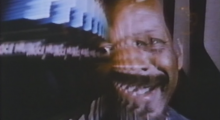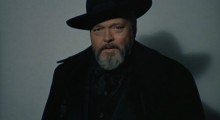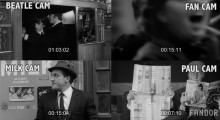Kevin B. Lee
-
Watch: What Does Oscar Nominated Cinematography Look Like in 2016?

Kevin B. Lee has been considering the candidates in the major Oscar categories. In this video essay, he breaks down the styles of the five candidates (The Hateful Eight, Sicario, The Revenant, Mad Max: Fury Road, Carol). The sound’s off as Lee narrates, but he also recommends watching the video silently to focus more on the cinematography. Pressed for time? You can read his essay here.
by Filmmaker Staff on Feb 4, 2016 -
Watch: The Tarantino Death Toll

Ever wonder how many people have died in Quentin Tarantino films? Or what’s behind the director’s seeming obsession with killing? Kevin B. Lee, Chief Video Essayist at Fandor, has tackled the bloody topic with a video essay on the body count in Tarantino’s films. Note the video’s warning: “the following video contains disturbing imagery of extreme violence and death.” In the text essay that accompanies the video (which you can watch above), Lee explains that he created this video after the release of Tarantino’s last film, Django Unchained, but this is the first time it’s being published (read the essay to understand […]
by Paula Bernstein on Dec 16, 2015 -
Watch: Shading and Cutting in Cassavetes’ Shadows

Amid all of the internet’s Kubrick/Anderson/Fincher devotees, few video essayists turn their scalpel toward Cassavetes, perhaps in part because his directing prowess is not so easily distilled. Kevin B. Lee has thus chosen to focus on the opening 14 shots of Cassavetes’ debut Shadows, and how he uses incisive editing and lighting to convey the shifting sentiments in a series of scenes between the two lovers Leila and Tony. Check it out above.
by Sarah Salovaara on Sep 28, 2015 -
Watch: Christopher Nolan’s Insomnia vs. the Original

In his latest video essay, Kevin B. Lee places the original 1997 Insomnia (directed by Erik Skjoldbjærg) on the left and Christopher Nolan’s 2002 Hollywood remake on the right. Juxtaposing the same sequence, Lee textually annotates the many differences in tempo, shot choices, framing et al., making it easy to see how two very different sensibilities approach the same sequence. More from Lee at Fandor.
by Vadim Rizov on Aug 28, 2015 -
Watch: How to Shoot a Road Movie

The road movie is a frequently tread subgenre, rife with comedic, episodic and dramatic potential. It can also pose a challenge for those seeking a varied mise-en-scene, and in this deconstruction of Dominga Sotomayor’s Thursday Till Sunday, Kevin B. Lee looks at the 83 ways in which the characters are framed in their rather contained environment. It’s a good primer on how to read a scene’s construction, and, from a directorial stand point, how to keep a static environment fresh.
by Sarah Salovaara on Aug 20, 2015 -
Watch: Ornette Coleman: Free Spaces

Shirley Clarke’s filmography is witnessing a much needed resuscitation thanks to the efforts of Milestone Films, and one specific title, Ornette: Made in America, is of particular pertinence given the untimely passing of its subject, Ornette Coleman. Kevin B. Lee has taken Clarke’s ever unusual documentary portrait — filmed over the course of 20 years — and divvied its often psychedelic tinged frames over a widescreen to analyze the visual patterns and rhythms Clarke achieves with her offbeat editing style. Watch above.
by Sarah Salovaara on Jul 1, 2015 -
Khalik Allah and Kevin B. Lee on Online Platforms vs. Festival Programming

Kevin B. Lee’s Transformers: The Premake and Khalik Allah’s Field Niggas are radically different films. Lee assembles footage of the making of Transformers: Age of Extinction and related materials to delve into how Michael Bay’s hyper-blockbuster took over cities all over the globe and made deals with their governments to save money; Allah’s film is an hour-long piece of street portraiture from 125th and Park in Harlem, giving voice to the routinely marginalized. What they have in common is that they both initially launched online before receiving festival play. Lee’s film is still online, while Allah has pulled his movie […]
by Vadim Rizov on May 12, 2015 -
Watch: Jonathan Rosenbaum on Orson Welles at 100

Today would’ve been Orson Welles’ 100th birthday, so to commemorate here’s a new video essay made by Kevin B. Lee with critic/avowed Wellesian Jonathan Rosenbaum. This clip-heavy overview argues that it’s more productive to think of Welles as a successful independent filmmaker who sometimes used Hollywood equipment rather than a failed prodigy who got himself kicked out of the studio system. Along the way, Rosenbaum touches on Welles’ views on actors, dislike of Antonioni, the way he stages combat scenes as if from a child’s point of view, and much more.
by Filmmaker Staff on May 6, 2015 -
Watch: Breaking Down A Hard Day’s Night Opening Sequence

Simple and effective: Kevin B. Lee breaks down the opening credits sequence of A Hard Day’s Night into four separate editorial strands. The main two are the “Beatles cam” trained on the running band and the “fan cam” following their screaming admirers; runners up are the “milk cam” (a guy eating in front of a milk ad) and the “Paul cam” (Paul in fake facial hair disguise, sitting out the pursuit). Each segment is timed with stopwatch precision, with all four parts arranged in a quadrant formation reminiscent of a security system, suggesting the surveillance that comes with celebrity. Very neat.
by Vadim Rizov on Mar 16, 2015 -
Watch: Eric Rohmer’s Uncertain Perspectives

I post my fair share of video essays, but arguably the most useful ones are the most specific, breaking down a filmmaker’s craft into a more ‘teachable’ method. Kevin B. Lee’s essay on the blocking, editing and camera perspectives at work in Eric Rohmer’s A Summer’s Tale is a prime example of the aforementioned. Lee clearly demonstrates how Rohmer crafts a world of uncertainty through reverse shots and eyelines, just as easily as he can lead the audience to side with a different character from one shot to the next via his cinematography.
by Sarah Salovaara on Mar 10, 2015
